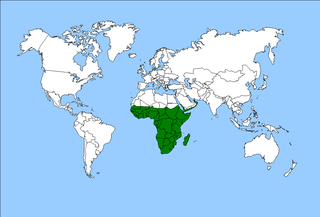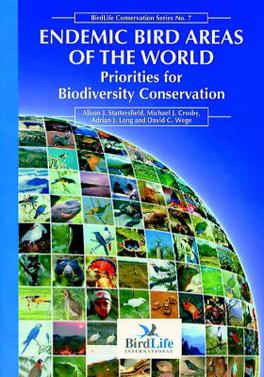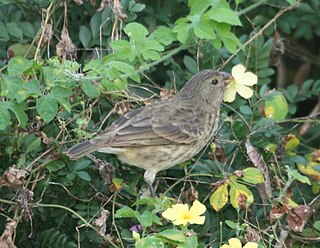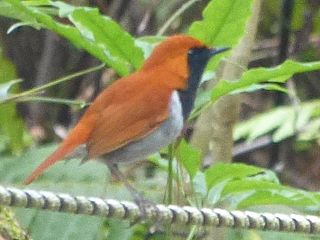Related Research Articles

The Palearctic or Palaearctic is the largest of the eight biogeographic realms of the Earth. It stretches across all of Eurasia north of the foothills of the Himalayas, and North Africa.

The Afrotropical realm is one of Earth's eight biogeographic realms. It includes Africa south of the Sahara Desert, the southern Arabian Peninsula, the island of Madagascar, and the islands of the western Indian Ocean. It was formerly known as the Ethiopian Zone or Ethiopian Region.
A biodiversity hotspot is a biogeographic region with significant levels of biodiversity that is threatened by human habitation. Norman Myers wrote about the concept in two articles in The Environmentalist in 1988 and 1990, after which the concept was revised following thorough analysis by Myers and others into “Hotspots: Earth’s Biologically Richest and Most Endangered Terrestrial Ecoregions” and a paper published in the journal Nature, both in 2000.

Endemism is the state of being a species found in a single defined geographic location, such as an island, state, nation, country or other defined zone; organisms that are indigenous to a place are not endemic to it if they are also found elsewhere. For example, the Cape sugarbird is found exclusively in southwestern South Africa and is therefore said to be endemic to that particular part of the world. An endemic species can also be referred to as an endemism or in scientific literature as an endemite.
An Endemic Bird Area (EBA) is an area of land identified by BirdLife International as being important for habitat-based bird conservation because it contains the habitats of restricted-range bird species, which are thereby endemic to them. An EBA is formed where the distributions of two or more such restricted-range species overlap. Using this guideline, 218 EBAs were identified when Birdlife International established their Biodiversity project in 1987. A secondary EBA comprises the range of only one restricted-range species, or an area which is only the partial breeding range of a range-restricted species.

The flora of India is one of the richest in the world due to the wide range of climate, topology and habitat in the country. There are estimated to be over 18,000 species of flowering plants in India, which constitute some 6-7 percent of the total plant species in the world. India is home to more than 50,000 species of plants, including a variety of endemics. The use of plants as a source of medicines has been an integral part of life in India from the earliest times. There are more than 3000 Indian plant species officially documented as possessing into eight main floristic regions : Western Himalayas, Eastern Himalayas, Assam, Indus plain, Ganges plain, the Deccan, Malabar and the Andaman Islands.

Endemic Bird Areas of the World: Priorities for Biodiversity Conservation represents an effort to document in detail the endemic biodiversity conservation importance of the world's Endemic Bird Areas.
Putting biodiversity on the map: priority areas for global conservation by C. J. Bibby, N. J. Collar, M. J. Crosby, M.F. Heath, Ch. Imboden, T. H. Johnson, A. J. Long, A. J. Stattersfield and S. J. Thirgood (ISBN 0-946888-24-8) is a 1992 book published by the International Council for Bird Preservation.

The Kangaroo Island emu or dwarf emu is an extinct subspecies of emu. It was restricted to Kangaroo Island, South Australia, which was known as Ile Decrés by the members of the Baudin expedition. It differed from the mainland emu mainly in its smaller size. The species became extinct by about 1827.
India is home to a large variety of wildlife. It is a biodiversity hotspot with various ecosystems ranging from the Himalayas in the north to the evergreen rain forests in the south, the sands of the west to the marshy mangroves of the east. India lies within the Indomalayan realm and is the home to about 7.6% of mammal, 14.7% of amphibian, 6% of bird, 6.2% of reptilian, and 6.2% of flowering plant species. India's forests contain about 500 species of mammals and more than 1300 bird species.

The pearly-eyed thrasher is a bird in the thrasher family Mimidae. It is found on many Caribbean islands, from the Bahamas in the north to the Grenadines in the south, with an isolated subspecies on Bonaire.

The small ground finch is a species of bird in the tanager family Thraupidae. Endemic to the Galápagos Islands, it is common and widespread in shrubland, woodland, and other habitats on most islands in the archipelago. It commonly feeds on small seeds and parasites from the skins of Galápagos land and marine iguanas and Galápagos tortoises.

The vegetarian finch is a species of bird in the Darwin's finch group of the tanager family Thraupidae endemic to the Galápagos Islands. It is the only member of the genus Platyspiza.

All of the animals living in Asia and its surrounding seas and islands are considered the fauna of Asia. Since there is no natural biogeographic boundary in the west between Europe and Asia. The term "fauna of Asia" is somewhat elusive. Temperate Asia is the eastern part of the Palearctic realm, and its south-eastern part belongs to the Indomalayan realm. Asia shows a notable diversity of habitats, with significant variations in rainfall, altitude, topography, temperature and geological history, which is reflected in its richness and diversity of animal life.

Biogeographic classification of India is the division of India according to biogeographic characteristics. Biogeography is the study of the distribution of species (biology), organisms, and ecosystems in geographic space and through geological time. India has a rich heritage of natural diversity. India ranks fourth in Asia and tenth in the world amongst the top 17 mega-diverse countries in the world. India harbours nearly 11% of the world's floral diversity comprising over 17500 documented flowering plants, 6200 endemic species, 7500 medicinal plants and 246 globally threatened species in only 2.4% of world's land area. India is also home to four biodiversity hotspots—Andaman & Nicobar Islands, Eastern Himalaya, Indo-Burma region, and the Western Ghats. Hence the importance of biogeographical study of India's natural heritage.

The Sulawesi lowland rain forests is a tropical moist forest ecoregion in Indonesia. The ecoregion includes the lowlands of Sulawesi and neighboring islands.

The Okinawa robin is a passerine bird endemic to Okinawa of Japan. It previously was considered a subspecies of the Ryukyu robin.
References
- Putting biodiversity on the map: priority areas for global conservation C. J. Bibby, N. J. Collar, M. J. Crosby, M.F. Heath, Ch. Imboden, T. H. Johnson, A. J. Long, A. J. Stattersfield and S. J. Thirgood (1992) ISBN 0-946888-24-8
- Endemic Bird Areas of the World: Priorities for Biodiversity Conservation Alison J. Stattersfield, Michael J. Crosby, Adrian J. Long and David C. Wege (1998) ISBN 0-946888-33-7